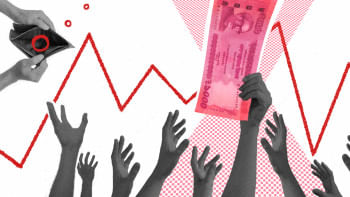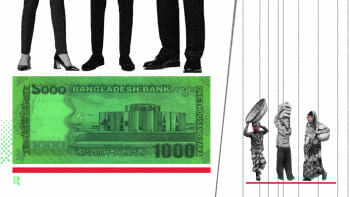Whom is the budget supposed to serve?

The annual national budget and the discussions on it are, in a sense, quite boring and unattractive. Because the budget is only an account of the government's income and expenditure, one can't expect it to make any fundamental changes to the economic structure. Year after year, the same kind of budget is prepared with a slightly increased amount than the previous year – a little less is allocated in some sectors while a little extra in others, depending on the priorities set by our policymakers who are usually influenced by the pressure, lobbying and demands of various powerful individuals, institutions, companies, organisations, etc.
On the other hand, the political economy of resource collection and distribution by the state and its impact on people's lives and livelihoods can be understood by analysing the budget. In that sense, the discussion and analysis of the budget is important, but to make it effective, one needs to shift the focus from size, growth, deficit, etc to the distributional aspects of the budget to understand how much money the government is collecting from which section of the society, and how the collected money is going to be used for the welfare of which section.
If we analyse the government's revenue collection plan under the proposed budget for the 2023-24 fiscal year, it becomes clear that, as always, the government is relying mostly on indirect taxes to increase revenue, which will put more inflationary pressure on the people who are already suffering from high inflation. Whereas in developed countries, 70-80 percent of the total tax revenue – in neighbouring India, it is more than 50 percent – is collected via direct taxes, in Bangladesh, at least 64 percent of tax will be collected from common people through indirect taxes like various duties and VAT on essential goods. Moreover, pressure will increase on the relatively low-income people in order to increase direct tax collection as well. While the surcharge-free asset limit for the rich has been increased from Tk 3 crore to Tk 4 crore, and the threshold of tax-free annual income has been raised to Tk 3.5 lakh from Tk 3 lakh, the government has proposed to make a minimum payment of Tk 2,000 for every TIN holder during tax return submission – whether they have a source of income or not. This means a large portion of the population, including pensioners and homemakers, will have to pay the minimum tax despite earning less than Tk 3.5 lakh.
The government has proposed to make a minimum payment of Tk 2,000 for every TIN holder during tax return submission – whether they have a source of income or not. This means a large portion of the population, including pensioners and homemakers, will have to pay the minimum tax despite earning less than Tk 3.5 lakh.
To meet the budget deficit, net foreign loans will be taken to the tune of Tk 102,490 crore, and Tk 155,395 crore will be borrowed from domestic sources. While benefits from these loans in the time of an economic crisis are questionable, the burden is sure to be borne by the general public.
This begs the question: how much of these funds will be spent for the common people's benefit, and how much will be used to patronise the vested interests? For example, 22 percent of the budget will be spent on public administration, 12.4 percent on interest payments, 5.5 percent on defence, 4.2 percent on public order, 11.5 percent on transport and communication, 4.6 percent on power and energy, etc. After that, not enough is left to be spent on healthcare, agriculture and social safety nets, and what is left is also not used properly.
While indirect taxes have been increased, allocations for their direct benefits have been decreased, which is evident from the declining proportion of budget allocations for agriculture, health, education, and social safety nets. Although the budget allocation for the agriculture sector has been increased in terms of monetary value, as a percentage of the budget, it has been decreased by 0.33 percent – from 4.97 percent of the current fiscal year to 4.64 percent of the next fiscal year. Similarly, allocation for the health sector has been increased by Tk 1,889 crore, but as a share of the budget, it has been decreased by 0.4 percent – from 5.4 percent of outgoing fiscal year to five percent in the upcoming fiscal year – and is just 0.76 percent of the GDP. According to the World Health Organization, at least four to five percent of GDP should be allocated to the health sector to ensure universal health coverage.
According to Unesco, four to six percent of a country's total GDP should be spent on education. In Bangladesh, it is already below two percent and is still decreasing. In the current fiscal year, it was 12.01 percent of the budget or 1.83 percent of the GDP, which has been reduced to 11.57 percent of the budget or 1.76 percent of the GDP for the upcoming fiscal year.
The allocation for the power and energy sector, on the other hand, has been increased to Tk 34,819 crore (4.6 percent of the budget) from Tk 27,066 crore (3.8 percent of the budget) in the outgoing year. But the increased allocation is mainly for the power sector; the budget for the energy sector's development has been reduced from Tk 1,798 crore to Tk 911 crore, which is not enough to solve the current energy crisis. As a result, import dependency of the energy sector will not be reduced, and the cycle of paying capacity charges by leaving the power plants idle due to fuel shortage will continue.
In the midst of the ongoing economic crisis, where allocation for social safety nets needed to be increased, it has been decreased as a proportion of the budget and GDP. Allocation to the social safety net programmes has been decreased from 16.75 percent of the current budget (2.55 percent of GDP) and 17.81 percent of the revised budget (2.65 percent of GDP) to 16.58 percent of the proposed budget (2.52 percent of GDP). There are already questions as to what percentage of this allocated money actually reaches the poor. The government survey itself showed that more than 46 percent of the registered beneficiaries were not eligible for the benefits. In addition, some programmes shown under this sector as a strategy to show more total allocation are not eligible for social protection programmes at all.
For example, 63 percent of the Tk 43,398 crore taka allocated as direct financial assistance will go to 800,000 government employees of grades 10-20 as pension payments. Apart from this, Tk 21,700 crore for subsidy in the agriculture sector, Tk 11,217 crore for interest subsidy on savings certificates, and Tk 5,000 crore for incentives given to small and medium enterprises have also been shown as social safety net allocation. As a result, fewer poor people will receive social safety benefits, and those who receive them will get much smaller amounts than needed. While the monthly allowance of the country's poor elderly men and women, widows and dependents, and the disabled has been increased by Tk 50 or Tk 100, the allocation for selling rice under VGF and OMS has been reduced by 29.33 percent and 9.76 percent, respectively, compared to the current revised budget.
While it is not clear how this budget will contribute to building a "Smart Bangladesh," as mentioned by the finance minister in his budget speech, it certainly seems to be a smart mechanism of taking more from the people while returning less – like the previous ones.
Kallol Mustafa is an engineer and writer who focuses on power, energy, environment and development economics.


 For all latest news, follow The Daily Star's Google News channel.
For all latest news, follow The Daily Star's Google News channel. 











Comments